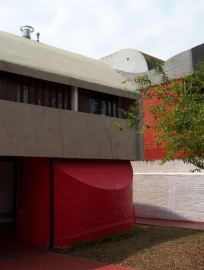30 Takes + Coda: The small invisible room and chaos theory
 Juarez Brandão's house, Grupo Arquitetura Nova, 1968. Photo: Edite Galote Carranza
Juarez Brandão's house, Grupo Arquitetura Nova, 1968. Photo: Edite Galote Carranza
Looking OVER this type of dependence and its mutations through time, what Edite Galote does bravely and with competence,
is breaking a taboo, is proposing an object of study that goes far beyond the history of architecture.
Marcos Napolitano,
Associate Professor at the University of São Paulo's School of Philosophy,
Languages and Human Sciences.
1. What separates order from chaos is a drop of water in the ocean.
2. About the Chaos Theory: It is one of the most important laws of the Universe, present in the essence of almost everything around us. The main idea of the Chaos Theory is that a small change in the beginning of any event can bring huge and absolutely unknown consequences in the future. Because of that, these events would be basically unpredictable – therefore, chaotic. It seems scary, but it takes just a quick look at life’s most casual phenomena to notice that this idea makes sense. Imagine that, in the past, you have missed the admission test to your dream college because a nail punctured the bus tire. Desolated, you go to another college. So, the people who you are going to live with are different, your friends will change, the lovers will be different, your children and grandchildren may be others…
https://super.abril.com.br/mundo-estranho/o-que-e-a-teoria-do-caos/
3. In the context of the Modern Architecture Theory, stabilized in its origin, Edite Galote Carranza, with her book The Small Invisible Room, introduces a wedge in the crack opened by the insertion of the servants’ quarters in the bourgeois housing program. Through Walter Benjamin’s against the grain concept, in opposition to going into the favorable, established and stable direction, the author therefore enhances with her small wedge that crack, so far invisible, in the compact monolith of official academic bibliographies.
4. And why would the feared chaos settle in a comfortable order - so wide and accepted such as the one of a Modern Architecture Theory which has the prestige of critical fortune in both national and international scopes if the Small Room - surpassed its invisibility status?
5. The question can be illustrated with the hedgehog example, a small mammal that has as distinction wrapping itself like a spike ball to shield from enemy: invasions.
6. And what would be the relation between the hedgehog and the Modern Architecture Theory?
7. As we know, the Modern Movement in Brazil had the merit of assuming a progressive posture in privileging a new housing program, in which urbanism elements articulated to the spatial relations of the domestic environment, such as the plaza or courtyard integrated to the house program, and the emphasis on the plastic solution as a way of contemplating, once more, the urban scale. However, this same program, would house, forcibly, the housemaid’s bedroom
8. About the integration of the plaza to the household functions’ plan and the plastic of the housing allied to the urban scale, we consider them as the main segment of Brazilian Modern Architecture.
]9. the concept of architectural spectacle will be understood from this pragmatic context that, to be applied in the architectonic solutions considered to be the boldest.
10. In this game of scales, urban and domestic, private and public an unavoidable difficulty to the Modern Architecture Theory is set: how to put such a modest issue so modest like the one of the housemaid’s bedroom? in a suitable, stable perspective, in a program of that level of ambition, We have considered this difficulty in three levels.
11. First: the small room was a demand outside the program, that is, a space opened to someone who is not a dweller, maybe some kind of servant or, even less, a guest. It is notable that the term servant designated not exactly the professional, but an intermediate function that covered a diffuse zone, because it was about a being who, not truly belonging to the private environment, would naturally be deprived from it.
12. Second: the small room implied a confrontation with social matters that, regardless of the Modern Architecture progressive axis and its adepts, lacked suitable instruments for its solution. Social transformations whose complexity, whether we want it or not, exceeds the professional architect demands, whatever was his project posture, should handle the deadlock.
13. Third: in face of the evident contradiction represented by the Small Room versus the Modern Architecture Theory, how to face the contradiction without exposing the wounded dignity of a project that proposed itself as transformation agent?
14. How to get rid of that malaise?
15. How to shed light on that matter without, at the same time, weaken the heroes of our generation?
16. How to forget that the same architect took two different positionsin face of the bourgeois housing program?
17. On the one hand, generous spaces, circulation courtyards with beautiful gardens, structural elements worthy of masterpieces, the most advanced technology, and on the other hand, cubicle and bathroom
18. Thinking about the servants and owners’ rooms in a same level of needs would be a nonsense, some would say; or hypocrisy, according to others. the opposite, that is, on one side, wide and generous spaces, and on the other, the intolerable Small Room, would be unworthy of progressive architects.
19. Admitting the Small Room in the noble space of the Modern Architecture Theory would be like introducing chaos in a comfortably established order. And the hedgehog wrapped itself like a spike ball
20. How to finally face the problem?
21. The solution found was as modest as exemplary: sweep the dirt under the carpet.
22. The housemaid’s bedroom would be measured in a special way as if it was about a human being different from the house dwellers or, if you wish, as if there were citizens of two different categories under the same roof, that is: the bourgeois family, from the upper class, and that kind of employee, a necessary evil, from the lower class
23. In some cases, the problem was faced through subterfuges, with undersized spaces, in the underground, with no window or proper illumination and ventilation.
24. The real estate speculation, another kind of evil that, if not necessary is at least invincible, created the ideal conditions for the neglect. The housemaid’s bedroom had windows opened to the laundry, were undersized and had bathrooms, for example, in which the shower was projected on top of the toilet seat or, in the best scenario, on top of the access door, a solution found by architects more sensitive to the problem.
25. In face of the deadlock, it was produced in the Modern Architecture Theory the invisibility phenomenon: no one talked about the matter and, in some publications, including books’, these spaces were not captioned, or its graphic pieces were even neglected.
26. Relied on such unglamorous theme, Edite Galote Carranza applied the against the grain concept to the Small Room and characterized it as invisible.
27. Edite Galote Carranza’s work soberly analyzes the intricacies and nuances of projects that constitute the rule in the bourgeois housing program, and then applies a magnifying glass in the space of the housemaid’s bedroom. From the representative works index, which admits disparities such as Warchavichik and Artigas, Longo and Vasco de Mello, the author highlights the critical awareness of the New Architecture group. At Juarez Brandão House, 1968, the housemaid’s bedroomgain relief in the house volume, in the frontal portion and, as if it was o’t enough, in red. The New Architecture not only fights the taboo but also coats it with a glaring visibility.
28. The proposal we intend to develop in this modest commentary about Edite Galote Carranza’s work is that a Critical Revision is necessary in the Modern Architecture Theory, a debate in all its complexity, including other than the great idolized matters, the smaller neglected matters, from the big events but also from small events, always in the same level of critical scrutiny.
29. In short: understand that the object of the Modern Architecture Theory is not a fossil but, thanks to its complexity and historical proximity, a living, dynamic and changing agent.
30. It is said that during the meeting between Bertrand Russel and Ludwig Wittgenstein, moments before the eventual admission of the Austrian philosopher to the University of Cambridge’s faculty, Russel would have said: there is no need to question everything; for example, it would be unnecessary to check if in this room exists a rhinoceros. In face of the affirmation, Wittgenstein stands up and starts to ostensibly turn the room upside down. You notice here to different postures. The first, dogmatic, adapted to the practice statute. The second rebels against the inertia of the sedimented knowledge.
31. Coda: we agree with Wittgenstein: it is healthy to question everything if beyond the goal exists the path.
References:
CARRANZA, Edite Galote. O quartinho invisível: escovando a história da arquitetura paulista a contrapelo. São Paulo: G&C, 2017.
About the author:

Ricardo Carranza. Writer. Editor of the electronic magazine 5% Arquitetura+Arte ISNN 18081142.
PUBLICATIONS in Anthologies of National Contests – SCORTECCI, SESC DF, literature magazine - CULT, and Poetry and Literature websites – Zunái, Stéphanos, Germina, Cult – Literary Workshop, Mallarmargens. Published Poetry BOOKS: Sextet, Author’s Edition, São Paulo, 2010; The Empirical Flower, Author’s edition, São Paulo, 2011; Dramas, Publishing G&C Arquitectônica Ltda., São Paulo, 2012. Unpublished Poetry Books – Sebo 2009-2016; Suns, 2014-2018; Pastiche, 2016, – partially published at Germina magazine. Sand Ovary 2009-2018; Worldliness Memorial 2018. Unpublished Tales BOOKS: The comedy of errors, 2011/2018 – pre-selected in the Literature Sesc Prize 2018; Anachronisms, 2015/2018. The village. 2016/2017. Christmas. 2016/2017. Unpublished novel: The Shell Society, 2017/2018. Insomnia Notebooks (58): sketches of poetry, tales, reflections, critical theory, spikes, dreams, fragments... since 2009.
How to cite:
CARRANZA, Ricardo. 30 Takes + Coda: The Small invisible room and the Chaos theory. 5% Arquitetura + Arte, São Paulo, year 14, v. 01, n.18, e121, p. 1-5, Jul./Dec./2019. Available at: http://revista5.arquitetonica.com/index.php/magazine-1/arquitetura/30-takes-coda-o-quartinho-invisivel-escovando-a-historia-da-arquitetura-paulista-a-contrapelo-de-edite-galote-carranza-e-a-teoria-do-caos
English translation by:
Caroline Parente Cardelino
M.A. Nívia Maria Rodrigues Fernandes Marcello
Acessos: 1880
